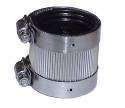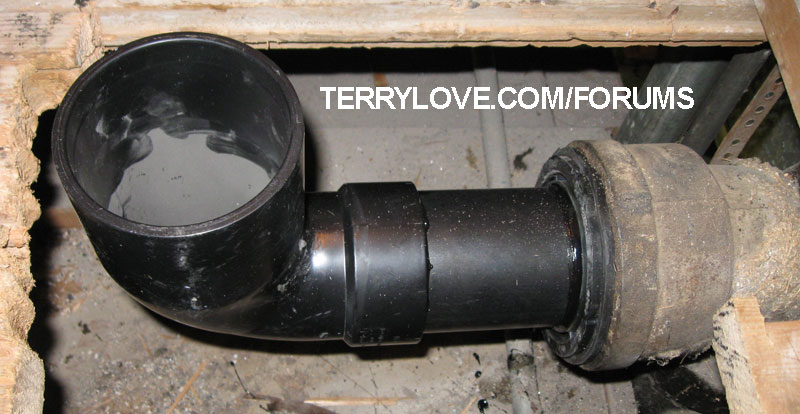I'm redoing my bathroom and trying to figure out how to replace my toilet waste pipe. The flange is attached to a black pipe (unsure of the material), which runs into a cast iron hubbed fitting. I am unsure if I can just cut the pipe that is running off of the cast iron pipe and then use a banded coupling to PVC, or if I should completely pull the waste pipe out of the hubbed fitting and replace the whole thing. If the latter is suggested, how do I go about installing the pipe into the hubbed fitting and what materials are required? Thank you.
You are using an out of date browser. It may not display this or other websites correctly.
You should upgrade or use an alternative browser.
You should upgrade or use an alternative browser.
Toilet waste pipe replacement
- Thread starter Nin28
- Start date
Users who are viewing this thread
Total: 3 (members: 0, guests: 3)
A picture would be handy here.
Sometimes, lead pipe will go into a cast iron hub fitting.
Lead is gray though.

If it's a black pipe, is it plastic or cast?
If it's one of those, then a coupling should work on it.
If it's gray lead, then most of the time, 99% and I want to extend or replace, I pull the lead from the hub, use a rubber fernco hub seal and insert a new pipe into the hub.
Some plumbers will pour a new lead joint.
Sometimes, lead pipe will go into a cast iron hub fitting.
Lead is gray though.

If it's a black pipe, is it plastic or cast?
If it's one of those, then a coupling should work on it.
If it's gray lead, then most of the time, 99% and I want to extend or replace, I pull the lead from the hub, use a rubber fernco hub seal and insert a new pipe into the hub.
Some plumbers will pour a new lead joint.
Sponsor
Paid Advertisement
With that, it's a lead bend, I can drill out the poured lead, and then pry out the rest, pull the lead pipe out.
I then use a Fernco insert for cast hubs, slide either a 4x3 ABS bush in, or a 4" pipe. If I use 3" pipe, I can use a spigot 4x3 closet 90, which allows a 4" hub closet to slip down onto it.
Other plumbers may do a poured joint. There are fewer around that can do that, and they are the stars of the plumbing world.

I then use a Fernco insert for cast hubs, slide either a 4x3 ABS bush in, or a 4" pipe. If I use 3" pipe, I can use a spigot 4x3 closet 90, which allows a 4" hub closet to slip down onto it.
Other plumbers may do a poured joint. There are fewer around that can do that, and they are the stars of the plumbing world.

Last edited:
Jadnashua
Retired Defense Industry Engineer xxx
Metals don't really get all that soft until they are almost liquid. You'll have great difficulties getting a 3-4" lead pipe hot enough without burning down the house, especially using propane. Cut it off, then drill the poured lead out of the cast iron hub enough to weaken the connection, then you can peel it out.
There is no way that you could ever get it hot enough with a torch.
Any bit that works. The lead is pretty soft. It can be a bit tedious for a while. Sometimes I get too much in a hurry and I break the bit sometimes.
Jadnashua
Retired Defense Industry Engineer xxx
Make swiss cheese out of it. If you use a big enough drill, you can drill down, then tilt the bit, taking out the lead between holes. If it is too small of a bit, that will break the bit off. Once you get enough out, you should be able to rock the pipe and then pull it out. It is a pain, but it works. The leaded joint may go down nearly the depth of the flange. There will likely be some oakum (oiled hemp rope) under it. When you see that coming up out of the hole, you'll know you went down far enough. Drilling the lead vs the ci should be fairly obvious - the lead is muc softer.
An alternative is to rent a snap cutter and cut the whole fitting out back to a straight section of CI. Works quick, and may end up being much easier in the long run.
An alternative is to rent a snap cutter and cut the whole fitting out back to a straight section of CI. Works quick, and may end up being much easier in the long run.
Last edited:
Geniescience
Homeowner
my experience is that copper and lead DO get easier to bend when they are heated up with any old flame. Like when I used a pair of pliers to twist out lead pipe and rip it. And copper too is easier to move into shape when a regular torch heats it up.
david
david
I got the set up you suggested Cass and I think I got most of the lead out. However, the pipe still won't budge. I'm using a mini pry bar to get it out and I'm getting a brown powder that is coming out? Any suggestions. And once again, thanks for all the help.
OK, now that I got the lead pipe out from the cast iron one, I'm replacing it with 4" PVC and a Fernco connector. The Fernco adapter goes into the cast iron pipe about 3/4 of the way in when inserted. What I basically did was bottom out the PVC as far as it can go in the cast iron pipe, and then proceeded to use a hammer and wedge to push the Fernco in. Is this good?
In addition, when I attached the 45" curved pipe, it is way over the height of the sub-floor, and will be way above the height of the tile floor. Any ideas how to fix this so it is level with the tile floor?
I've included 2 pictures of the pipe. Thanks!
In addition, when I attached the 45" curved pipe, it is way over the height of the sub-floor, and will be way above the height of the tile floor. Any ideas how to fix this so it is level with the tile floor?
I've included 2 pictures of the pipe. Thanks!
Attachments
Similar threads
- Replies
- 2
- Views
- 105
- Replies
- 22
- Views
- 453
- Replies
- 25
- Views
- 1K
- Replies
- 0
- Views
- 147





